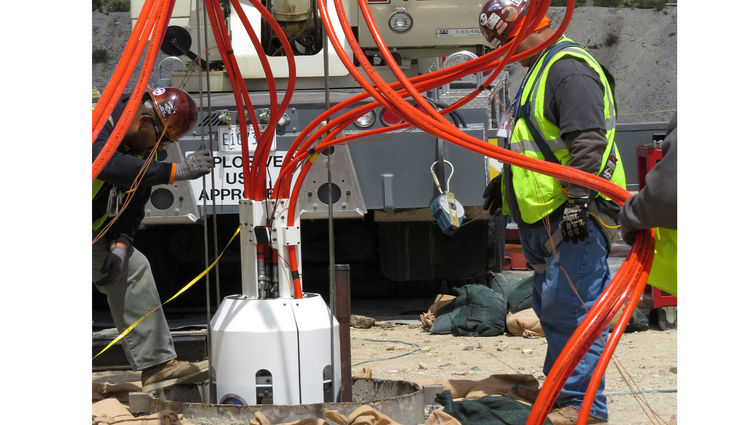Laboratory's role in underground explosives tests will help nation's detection capabilities
 (Download Image)
Two workers oversee the emplacement of the canister that contained the chemical explosive charge for Source Physics Experiment-4 Prime at the Nevada National Security Site. The shot execution was led by Lawrence Livermore National Laboratory's Leon Berzins, who was assisted by Beth Dzenitis, the deputy SPE campaign manager for the Laboratory.
(Download Image)
Two workers oversee the emplacement of the canister that contained the chemical explosive charge for Source Physics Experiment-4 Prime at the Nevada National Security Site. The shot execution was led by Lawrence Livermore National Laboratory's Leon Berzins, who was assisted by Beth Dzenitis, the deputy SPE campaign manager for the Laboratory.
A Lawrence Livermore National Laboratory (LLNL) team played a leading role in fielding the recent Source Physics Experiment (SPE-4 Prime) detonated at the Nevada National Security Site (NNSS).
The SPE tests, including the most recent one on May 21, consist of a series of seven underground, high-explosive field tests in hard rock that are designed to improve the United States’ ability to detect and identify low-yield nuclear explosions amid the clutter of conventional explosions and small earthquakes.
"As nuclear monitoring scientists, we are very excited by the new data from SPE-4 Prime," said Bill Walter, the SPE scientific leader for LLNL and the SPE-5 chief scientist. "It is the most over-buried field explosion in granite from which we have ever obtained data, and the data return and quality look excellent.
"We will be able to compare this new data with the prior SPE shots, which were shallower, allowing us to directly measure and understand the role that the interactions of the Earth’s surface play in generating the signals we observe."
The SPE-4 Prime experiment was detonated with a chemical explosive equivalent of 196 pounds of TNT in a contained environment 286 feet below ground.
A team of 27 LLNL engineers and technicians, led by physicist and SPE Campaign Manager Leon Berzins, was responsible for the design of the canister that contained the explosive charge, along with emplacing the canister downhole. LLNL also was responsible for the timing and firing of the shot.
The chemical explosives for the experiment were placed downhole in a one-and-a-half-week process that included a dry run of emplacing a canister without high explosives, Berzins said.
"It had been close to two years since we had our last SPE chemical explosion, so it was great to have this test to produce scientific data for our simulation and modeling work," said Berzins, who worked on nine of the Laboratory’s 13 subcritical tests between the late 1990s and 2003.
"Livermore took on this challenge and was able to draw upon a wide spectrum of talent to be successful," he said, noting that a number of Lab employees worked nights and weekends at LLNL and NNSS.
When Livermore and Los Alamos National Laboratory (LANL) conducted nuclear tests from the 1950s through 1992, the tests were conducted in a narrow range of depths and sizes for safety and cost factors.
"We’re trying to expand that range, so we can understand any potential future nuclear tests that would be outside the historic range," Walter said. "The SPE tests are designed to improve our numerical modeling codes for monitoring nuclear explosions overseas."
Information gathered from the experiment includes high-resolution accelerometer, infrasound, seismic, explosive performance, ground-based light detection and ranging (LIDAR), ground-based hyperspectral imagery and satellite data.
The sensor networks reported a successful data return that will advance current, state-of-the-art ground motion and seismic wave propagation models and algorithms toward a predictive capability.
"The seismic Source Physics Experiments substantially advance the United States’ efforts to develop, validate and improve on emerging technology," said National Nuclear Security Administration (NNSA) Deputy Administrator for Defense Nuclear Nonproliferation Anne Harrington.
The SPE tests represent a U.S.-interagency-wide endeavor, with NNSA’s NNSS, LANL, LLNL, Sandia National Laboratories and the Department of Defense’s Defense Threat Reduction Agency all serving as partners in SPE-4 Prime, along with the University of Nevada-Reno.
NNSA’s three national laboratories have already used the data from the first three experiments in the series (SPE-1, executed in May 2011, SPE-2, executed in October 2011 and SPE-3 executed in July 2013).
NNSA has published a press release on the event.
The next shot in the SPE series, SPE-5, is slated to be staged during the fall at NNSS.
Contact
 Stephen Wampler
Stephen Wampler
[email protected]
(925) 423-3107
Related Links
NNSA press releaseTags
Physical and Life SciencesStrategic Deterrence
Featured Articles







